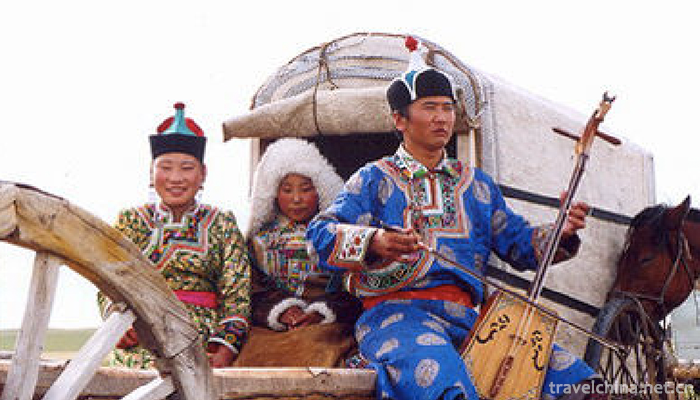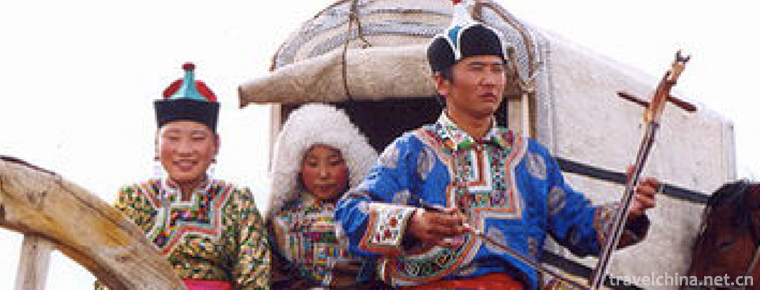Horqin Chaoer Epic
Horqin Chaoer Epic
Horqin epic is a local tradition of Mongolian heroic epic. It is the only living epic in Horqin area of Inner Mongolia Autonomous Region. "Chao Er Playing Method", "Overtone Playing Method", "Hu Er Playing Method" and "Solid Sound Playing Method". Its content tells the story of the transformation of the universe, the ups and downs of the world, expounds the origin of human species, the formation of ideology and the construction of social order, etc. It expresses the good wishes of human beings for truth, justice, peace and harmonious coexistence.
On June 7, 2008, the "Horqin Chaoer Epic" declared by the left-wing Middle Banner of Horqin, Inner Mongolia Autonomous Region, was listed in the second batch of national intangible cultural heritage list with the approval of the State Council.
historical origin
Horqin Chaoer epic is a local tradition of Mongolian epic, which is popular in Tongliao City and Xing'an League in eastern Inner Mongolia. Horqin Chao Er's epic is accompanied by an ancient bowstring instrument called Chao Er. Chao Erqi, a special epic artist, performs rap and singing in the form of self-help singing. The content tells the story of the God who came down from the womb and grew up to be a Khan and a hero. He fought with Python Gusi, the devil who endangered the world, to defend his hometown and to safeguard peace.
artistic characteristics
Music
Music melody has its own system, totaling 9 sets and more than 20 pieces, and can be changed freely in the presentation.
content
There were dozens of Horqin Chaoer's epic repertoires. Among them, "Eighteen Pythagus Gusien Uliger" is a large series of epic poems, which is composed of eighteen relatively independent but interrelated epic poems. Its scale and length can keep pace with the famous "Gusser" and "Jiangger".
Musical Instruments
Chaoer, an ancient bowstring instrument, is mainly used to accompany epic or Narrative Folk songs, with double strings, fixed strings of four and five degrees. Its timbre is old and honest, its overtone is rich, and it has extremely diversified musical expression.
Inheritance significance
Horqin Chaoer's epic has a long history, a wide distribution area and a wide audience. Its unique style, self-contained skills and strong artistic expression. It integrates narrative, lyric and intonation with simple and vigorous style, bold and unrestrained style, and closely links with the unique language, history, religion, psychology, world outlook, ecological outlook, outlook on life, customs and habits of grassland people, which centrally reflects the characteristics and characteristics of grassland culture.
Horqin Chao Er epic is a local tradition of Mongolian heroic epic and the only living epic in Horqin area of Inner Mongolia Autonomous Region. Its content tells the story of the transformation of the universe, the ups and downs of the world, expounds the origin of human species, the formation of ideology and the construction of social order, etc. It expresses the good wishes of human beings for truth, justice, peace and harmonious coexistence. Chaoer, as the oldest and most representative instrument of Mongolian, fully embodies the comprehensive characteristics of Mongolian people in instrumentation, acoustics, technology and musicology.
Inheritance and protection
Although the 20 Horqin Chao Er epics mastered by Burenchu Gula have been well preserved, due to the complex religious and folk meanings of Horqin Chao Er epics, it is impossible to reconstruct its inherent living context in a short period of time under the current social and cultural background. He was hired as a visiting professor. On the one hand, he enrolled professional students through the educational platform in order to inherit them. On the other hand, he steadily promoted the regeneration and reconstruction of Horqin Chaoer epic in rural pastoral areas on the basis of full investigation and research.
Over the past 100 years, with the change of Mongolian society and culture, the art of heroic epic tends to decline. By the 1990s, most of the living epic traditions in Inner Mongolia had basically disappeared. Like other regional epics, Horqin Chao Er's epic was once thought by the academic circles to have lost its vivid inheritance.
After a thorough field investigation, in 2005, we found that the only inheritor of the Horqin Chao Er epic known to us was Burenchu Gula and 20 Horqin Chao Er epics carried on him.
This is of great discovery value and historic significance for the rescue, protection and inheritance of Mongolian epics.


-
1.Mung bean soup
Mung bean soup is a soup boiled with mung bean and water as the main ingredients. It has the functions of clearing heat, detoxifying, quenching thirst and relieving heat
Time 2018-11-02 -
2.Baishuiyang Yuanyangxi Tourist Area
Baishuiyang Mandarin Creek is located in Pingnan County, Ningde City, Fujian Province. It is 170 kilometers away from Fuzhou and 101 kilometers away from Ningde
Time 2018-12-08 -
3.Fairy Lake Xianhu Botanical Garden
Xianhu Botanical Garden is located in Liantang Xianhu Road, east suburb of Luohu District, Shenzhen. It relies on Wutong Mountain in the East and Shenzhen Reservoir in the west.
Time 2018-12-22 -
4.GongQing Forest Park
Gongqing Forest Park is located in Yangpu District, Shanghai. It is bordered by Huangpu River in the East and Military Road in the west. The total area of the park is 1965 mu, and the open public
Time 2018-12-24 -
5.Yellow River Grand Canyon
The Yellow River Grand Canyon is located in Qingtongxia Town, Wuzhong City, Ningxia. It is 20 kilometers away from Wuzhong City. It is a scenic spot of the Yellow River Canyon composed
Time 2019-01-18 -
6.Shenyang Weipo Skiing Ground
Shenyang Qiaopo International Skiing Resort is located in AAAA Scenic Area of Qiaopo in Shenyang, which is surrounded by mountains in the northeast direction and boundless forest sea.
Time 2019-02-08 -
7.The Story of Barragan
Stories of witty figures of the Mongolian people in China. Long-term spread in Inner Mongolia, Xinjiang and other Mongolian areas. The protagonist Balagan Cang is the representative of the working peo
Time 2019-04-02 -
8.Quanzhou North Pipe
Beiguan, also known as Beiqu, Xiaoqu, Quzi, is a kind of traditional folk silk and bamboo music widely spread in Quangang District, Quanzhou City, Fujian Province. China's Beiguan is now only distribu
Time 2019-06-11 -
9.Guangxi drama
One of the local operas of the Zhuang nationality in Guangxi. Yongju Opera belongs to the Pihuang Vocal Tune System, which originated in Hunan. It was formerly called Guangju Opera, Old Opera, Local O
Time 2019-07-14 -
10.General situation of Chengdu Giant Panda Base
According to the information on the base's official website in May 2017, Chengdu Research Base for giant panda breeding implements a three-level management mode of "Director Office Department (Center) - team". The director's office has 5 leading posts, including 1 Director and 4 deputy
Time 2020-12-13 -
11.The second industry of Panzhihua
In 2018, the total industrial added value of Panzhihua was 69.163 billion yuan, an increase of 7.0%, and its contribution rate to economic growth was 59.7%. At the end of the year, there were 325 Industrial Enterprises above designated size. The production and sales rate
Time 2020-12-14 -
12.Neijiang secondary industry
By the end of 2019, there were 329 Industrial Enterprises above Designated Size in Neijiang City, and the added value of industries above designated size increased by 9.5%. The added value of the five traditional pillar industries increased by 9.8%, including
Time 2020-12-16